#Bear Totem Pole
Explore tagged Tumblr posts
Text















Teddy Day
Teddy Day is an annual event held every February 10. We are ecstatic to be celebrating love and companionship via one fluffy friend that is always there no matter what — Teddies! Teddy bears, as the name implies, are stuffed toys often made to resemble a bear, and bears are known for their hugs, although fatal. But ours is one of love which is what this day is all about.
History of Teddy Day
Stuffed toys have been children’s best toys since ancient times. They are soft, squishy, and a good companion for all. In the Roman Empire, the children of the rich had wooden carved toys in the shape of animals and humans they played with, and it was such that only the children of the rich could afford and get them. So the children of the low class and peasants developed ragdolls made from clothes and straws, and over the years, they evolved into stuffed toys as we know them in the world today.
Teddy bears are soft fluffy toys in the shape of bears that evoke feelings of love and warmth when we hold and hug them. They come in different sizes; small, medium, large, and even plus size. Like all other stuffed toys, Teddy bears have evolved from being toys for children to being toys for everyone, including men and women. So during the cold, lonely nights and when we’re feeling emotionally down or happy, teddy bears serve as a great cuddle companion.
Teddy bears got their name in 1902 after President Theodore Roosevelt in a series of events that happened when he went on a hunting trip. During hunting, they happened upon a bear, and President Roosevelt refused to shoot it. The story soon spread all over, and the first stuffed bears were developed by toymakers Morris Michtom in the U.S, and Richard Steiff in Germany, and they were named ‘Teddy bears,’ after President Roosevelt’s pet name.
Teddy Day is a time to show love to our special persons and significant others by gifting them teddy bears. It shows how special they are to us and the warm and lovable feelings they bring to us, just like teddies.
Teddy Day timeline
1880 First Stuffed Toy
The first modern stuffed toy in the shape of an elephant is sold as a pincushion by the German Steiff Company.
1902 The Inception of Teddy Bears
After the incident with President Roosevelt where he refused to shoot a bear on a hunting trip, stuffed teddy bears are developed and become popular.
1906 Bear Book
A book on bears is written by Seymour Eaton, a children’s books series called “The Roosevelt Bears.”
1984 Teddy Museum
The first Teddy Bear Museum is set up in England.
Teddy Day FAQs
Why are Teddies so comforting?
Their fluffiness and softness possess a calming ability that eases the mind and emotions. Research has found that cuddling them releases oxytocin which calms the body.
At what age should a child stop sleeping with Teddies?
There is no specific age limit to sleeping with or having teddies. More than just being toys, they are also tools of convenience.
Can a baby sleep with a teddy?
It had been advised not to put stuffed toys beside children below 12 months because of the risks of death by strangulation or suffocation.
Teddy Day Activities
Gift a Teddy
Buy a Teddy
Become a Teddy
How can you observe Teddy Day without a Teddy? Gift your special someone a teddy bear and tell them how much you love them.
Other than giving teddies to your special someone, this is also a good time to get one for yourself. Visit your favorite stores and get yourself a fluffy teddy companion on this day.
Your partner might have lots of teddies already, putting you at a fix, but not to worry. Instead, rent a teddy bear costume to entertain your partner and make their day.
5 Important Facts About Teddies
Winnie the Pooh
Spacefarer bear
Teddy Magazine
Teddy Guinness record
World biggest Teddy
The most famous teddy in the world, Winnie the Pooh, created by author A. A Milne is named after a female bear named Winnipeg in the London zoo he frequented with his son.
The first teddy bear to journey into space is named Magellan T. Bear, which joined the NASA shuttle mission in 1995.
There is a magazine dedicated to teddy bears that has more than 40,000 subscribers called “Teddy Bears and Friends.”
The largest teddy bear collection in the world is 20,367, owned by Istvánné Arnóczki in Hungary on April 27, 2019.
The biggest Teddy bear in the world is located in Estado de Mexico, at 63 feet and eight inches.
Why We Love Teddy Day
Teddies are lovable toys
Helps on cold lonely nights
Teddies can be therapeutic
The fluffiness and cute appearance of teddy bears make us easily fall in love with them. Many manufacturers make them have wide beautiful eyes and innocent-like looks, which warms the heart and sends warm feelings always.
Some nights can be very terrible without a cuddle companion nearby. Teddies are one cuddle companions we can always count on to help us through the cold, lonely nights.
Research has found that cuddling a Teddy bear can be calming. Police, medical and fire officials reiterate the fact that giving a child a teddy during a crisis has calming effects on them.
Source
#Max Gam Ol by Clint Adams#Terrace#Bear Affection by Mike Tyler#Whistler#Spirit Bear Mother#“How the Animals Got Their Names” by Smoker Marchand#Omak#Trees of Mystery#Klamath#California#roadside attraction#too touristy#USA#Boston#Massachusetts#original photography#travel#vacation#Tufts Medical Center#Bear Totem Pole#South Lake Tahoe#Quebec City#White River#Ontario#Winnie-the-Pooh#Canada#cityscape#tourist attraction#landmark#Hope
1 note
·
View note
Text

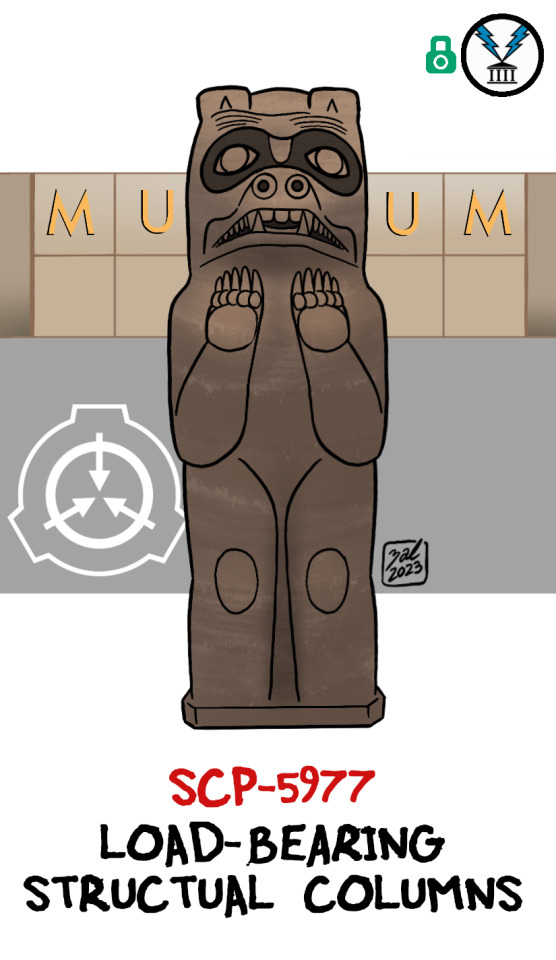

SCP-5520 | SCP-5977 | SCP-7056
#scp foundation#scp#on guard 43#site 43#canada#fan art#fanart#scp art#scp cards#totem pole#bear#underground#lake huron#researcher#scientists#old man#ontario
117 notes
·
View notes
Text

Mike Roy (attributed) - Smokey the Bear #4 Cover Original Art (Gold Key, 1970) Source
5 notes
·
View notes
Text
yeah I'm Alaskan native , im like kinda a big deal
#bear barks#i try to remind myself that sometimes cause its easy to forget#my mom is half black and alaskan and i think her mom is full just like her grandma#im sure everyone has that one predominant race they put down when theyre only allowed to put one on those race sheets#i always pick alaskan native#you see alaskan native art a lot here in wa#raven and salmon art#but its just stylized#still cool thougj#they got totem poles around too
0 notes
Text
Cultural Architecture: NWT Totem Poles - The Specifics Pt. 2
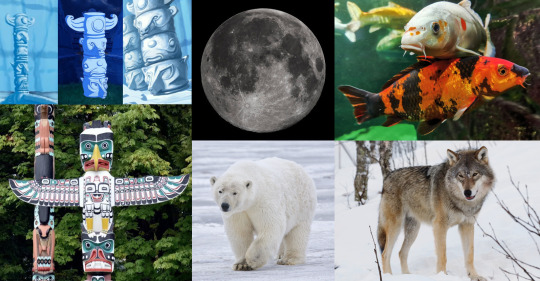
Among most of the totem poles we see throughout the Northern Water Tribe (NWT), four representations appear consistently throughout. For this post, I will be covering the final two.
Koi Fish
The third totem is clearly a koi fish with long whiskers and a marking on its forehead. In other words, it's a reference to the physical forms of the moon and ocean spirit. I can't help but wonder if Aang's realization of Tui and La's true forms was unconsciously informed by the all the koi head totems omnipresent throughout the NWT.
Culturally, koi fish are yet another example of the Chinese influence in the NWT. In Chinese culture, koi represent fame, family harmony and wealth. There's also a famous Chinese folktale about koi fish and other carp:
Along the Yellow River, there is a legendary waterfall that cascades from a magical mountain top known as Longmen (登龍門), meaning the Dragon's Gate. If a carp can swim upstream against the currents and hop over the waterfall into Longmen, the fish will transform into a dragon.
Thus, koi fish can also represent determination, courage, and perseverance. The connection between koi and dragons also strengthens the fan theory that the dragons Ran and Shaw might be the Fire Nation's equivalent to Tui and La. Perhaps the dragons are the spirit of Sun and Fire respectively?
Wolf
The totem beneath the koi depicts a wolf. The wolf head totem also bares a striking resemblance to the headdress that Sokka wears in "Day of the Black Sun" (Season 3, Episode 11). Wolves are prominent figures in the mythologies of many Indigenous American cultures, particularly those whose societies were oriented around hunting.
Within different Inuit groups, wolves are called amarok (multiple groups), amagok (Inuvialuit), and amaguk (Inupiat). These names refer both to normal wolves and to the gigantic, supernatural wolf of Inuit religion. There are two Amarok-focused tales that I'd like to detail in this post:
A persecuted and physically stunted boy seeks to increase his strength. When he calls out to the lord of strength, Amarok appears and wrestles him to the ground with its tail. This causes a number of small bones to fall from the boy's body. The Amarok tells the boy that the bones had prevented his growth; he instructs the boy to return daily in order to develop his strength. After several days of wrestling with the Amarok, the boy is strong enough to overcome three large bears, thus gaining him the esteem of his village.
The land was once full of caribou; the people lived well and were happy. But the hunters only killed those caribou that were big and strong. Soon all that was left were the weak and the sick. The people began to starve. And so they called upon Amorak, the spirit of the wolf, to winnow out the weak and the sick, so that the herd would once again be strong. The people realized that the caribou and the wolf were one, for although the caribou feeds the wolf, it is the wolf that keeps the caribou strong.
From these two stories, we get quite a nuanced conception of what the wolf represents in Inuit culture. While wolves represent strength in many cultures, these tales really emphasize the wolf as a creature that strengthens those around it. Through this worldview, we understand strength not as an innate or individualistic quality, but one that's nurtured through mentorship and interdependence.
This makes Sokka's adoption of wolf imagery during "Day of Black Sun" all the more appropriate. Sokka is certainly not the most powerful character in the show, but his role as the leader strengthens the group as a whole.
Like what I’m doing? Tips always appreciated, never expected. ^_^
https://ko-fi.com/atlaculture
336 notes
·
View notes
Text
A.K.A. Why Lilia Vanrouge is Awesome!!!

I'd like to apologize.
Heavy spoilers for the English content for Book 7 as I will need to delve into Peepaw Lilia's backstory for this to make any lick of sense, so if you haven't caught up, you'll have to skip 😔
More after the cut V●ᴥ●V
Since there's a good many of you guys who would need context for the whole "counter culture" thing, I'll have to dive into the history of the punk movement for a bit, so please bear with me.
So, what even is punk? Punk is an attitude, a way of life, but it wouldn't be anything without its music. Begining in the 70s with most of its origins in England and North America, it rejected the "conformist" nature of music at the time, talking about anti-establishment and, what do you know, counterculture! They were big on freedom of expression and showing off their individualality, regardless if it was "acceptable" or "proper" in the eyes of the layman.
Why do I bring this up? Well, because of Lilia's involvement in the Pop Music Club!

Music being one of the key elements here, I noticed in one of his vignettes how Lilia is often cited to be able to growl, similar to death metal screams (this being due to his ability to modify his vocal chords with magic due to the ancient fae language, which is being spoken less and less withing Briar Valley) and interestingly enough the growl has actually some roots in punk and emo scenes!
youtube
Lilia also tends to have his tastes in fashion mostly derive from punk and goth related fashion, like fish nets, black nail polish, and even his hair!

See what I'm seeing?
🦇☠️🦇☠️🦇☠️🦇☠️🦇☠️🦇☠️🦇☠️🦇☠️🦇
So... what's the point?
I'm sure this is where you've come to, the whole point of this. Well, it all starts with his past!
Lilia was born an orphan, with no family or royal history prior to being taken in by the Draconians, and, despite being a bat fae, which is one of the lower ranks of the totem pole next to pixies, is not only the most infamous and powerful soldier in Briar Valley's fae army, but was able to befriend the land's princess and her soon to be husband and gain the respect of many.
This was a problem for the higher ups of Briar Valley, who, clearly show a bias towards how they think the hierarchy should go.
Ergo, the Council:

BOOOOO- Ahem.
The Council is introduced as the spirits of the royals (assumedly non-monarch) who had long since passed from their time yet decided to use their powers to protect the original castle of Briar Valley, the place even Queen Malenoa (Mal's grandma) resides.
They're also... incredibly classist. The air around them and Lilia was palpable (kudos to the writing team for that) as they don't hold any of their ignorance back with not only blaming Lilia for the death of their Queen, who very willingly sacrificed herself for the safety of her egg. Calling him "filthy" and "foolish" even after he nearly died himself, twice in fact.
And then, when they or the Queen or the other royals couldn't get the egg to hatch after many, many failed attempts due to Malleus rejecting their magic, the Queen called Lilia back to the capital to find a means to get their prince to finally hatch or he'll die.

And after many, many travels to the other lands and even allowing Malleus to absorb his lifeforce, again, sacrificing himself all for the sake and well being for his country, what do they do? Do they thank him for this heroic act?! Nope! They brandish him again as filthy and plot to hide the details of Malleus's birth regarding Lilia's sacrifice out of pure hater energy!
And, I'm sure you're aware of it, but the story is practically screaming at us that the Council is the physical manifestations of the old ways of Briar Valley, a.k.a. the status quo (kinda like the music/fashion was prior to the punk explosion) while Lilia is the counterculture!
From his multi-colored hair, to his ability to rub shoulders with the FREAKING RULERS of the land and could GET THEM TO LIKE HIM, to his ever changing views of humans and his own home. Lilia's very existence spits in the hypothetical faces of the Council members!
To put it into terms it's like this: if pixies were goombas, then Lilia would probably be like a Koopa Troopa- and to the Council, it's as if the Koopa Troopa became a Bullet Bill!
He's the very reason why Malleus himself has a less hostile impression of humans; his current self is completely different from how he was when introduced to Silver as a baby.
So! What do y'all think? Do you agree with the takes in this post? And do you have any questions/concerns about it?
Did I miss something?
If you liked it please feel free to leave your reactions! I hope to make more in the future! Bye for now!
#twisted wonderland#anime#manga#disney#lilia vanrouge#twst silver#diasomnia#night raven college#punk rock#punk culture#the clash#history#music#book 7 spoilers#Youtube
35 notes
·
View notes
Text
Padmé is Load Bearing for Anakin, and by late RotS she is the only thing that is helping him maintain his sense of self.
Let me explain ^^.
a) Anakin grew up in an environment where people could beat him, and punish him, and deprive him of anything they wanted, and order him around, simply because they were powerful, and he wasn't, and there was nothing he could do about it except make himself useful as best he can. The only things he can rely on is his own competence and his own usefulness. This probably instilled in him some ideas about How The World Works.
b) The counterpoint to this, obviously, is Shmi, with her philosophy of kindness and helping each other out - emotionally, this rings true, and Shmi fulfills Anakin's psychological needs in a way nobody else does, and he wants to make her happy and proud. But Shmi too is powerless to stop anything that's happening to her.
Then the Jedi come, and they take him on. Why? Because he is good at things. Because he is powerful. He won the podrace. He is strong in the Force. Shmi, who is not powerful, is left behind.
The Jedi philosophy preaches b), but the shape of the events surrounding Anakin's acceptance into the Order, from Anakin's POV, screams a). Obviously there is more nuance to it, but not nuance that Anakin would be able to perceive or understand.
This creates a kind of inherent tension in the way Anakin approaches the world, because over and over again he is in situations where, to gain the approval and affection of his loved ones, Anakin should be b), but what's effective, what gets him where he wants to be, is a). Except, unlike with Shmi and the slavers, the Jedi are kind of both sides simultaneously, in his eyes.
Except there's also Padmé. Padmé, when she meets Anakin, is nobody to him, and he is nobody to her. She is obviously high up on the societal totem pole (though he doesn't yet know how high), and she has little obvious use for him, she has nothing to do with the Jedi or midichlorian counts or strength in the Force, but she is still nice, and caring, and kind.
Then, he learns that she's the fucking Queen of Naboo. Can you imagine how he feels about that? In his eyes, she really is an angel. Unlike Shmi, she's not a fellow disenfranchised person, she is so high up he really can't be of any use to her at all, and she still took the time to comfort him and treat him as a person.
Now Anakin knows that there is a person - outside of his immediate family - who will care about him even if he's not useful or powerful. It's no wonder he keeps thinking about her for years - he's struggling with being a good Jedi, with reconciling the abovementioned a) and b), with his emotions and self-control, with the fear that the Jedi will turn him out if he's not good enough (Obi Wan says he cares - but would he still care if Anakin disappointed him?), so of course he'll mentally escape into the fantasy of boundless, unconditional love from a beautiful, genteel woman.
And then - and this is the crux of my argument - the Tusken massacre happens.
It happens because, in that moment, the stark apparent uselessness of approach b) is particularly salient to Anakin: Shmi had been kind her whole life, she always insisted on Anakin being kind and selfless and helpful, and this is what she got from it, it got her nowhere, it got her tortured and killed with nobody to stop it. So approach a) - a massive show of ruthless strength, PUNISH!! - becomes the only possible reaction for him.
BUT STILL, he knows that this would have immensely disappointed her, and more importantly he knows that this would immensely disappoint the Jedi if they knew about it, he knows that he could suffer rejection and casting out and, well, serious legal consequences if they found out.
From this point on, Anakin's fate with the Jedi is sealed. There's nothing they can do to help him, any validation they give him will not reach him in any way that matters, because he is presenting a facade to them and he knows it in his bones that who he truly is would be fundamentally unlovable for the Jedi (I don't know whether this would truly be the case, but the important part is that Anakin is sure it is). Ultimate imposter syndrome baybeee.
BUT there's Padmé. Padmé understands. Padmé is still willing to see him as a good man. In a world that seems cleaved in two in such a way that he can either be cruel and unlovable and completely defined by his power and competence and alone, or roll over and be kind and let people hurt him (he knows no option c), while his identity is unraveling because he has built it on a foundation of others' approval and he knows that approval is not coming or deserved, Padmé is once again the only true thing in his life, the only oasis in a sea of conflicting expectations. She has seen the worst of him, and she is still there, in a way the Jedi would never be. She IS option c). She is stability. She is something outside of himself that holds together the fractured pieces of his self-image and his conflicting worldviews. Without her he'll fall apart.
This is why he functions so much better during the Clone Wars. This is how he gets to be a good master for Ahsoka.
But as far as he's concerned, the relationship between him and Ahsoka is a one-way street, because Ahsoka doesn't really know him. He has molded himself into what Ahsoka needs, as he has tried to mold himself into what his slavers or the Jedi needed, but the face he presents to her is ultimately a kind of facade, a splitting of the "good parts" of him and the suppressed parts that would bring him to do horrible things like massacre the Tusken raiders. This is where his perception of "Anakin" and "Vader" as two different people originates. For him to heal this split, he would need to see that he is accepted by others despite his genocide, and to reveal what he did is too great a risk because... well, fucking genocide.
And this is, essentially, why Ahsoka can leave and Padmé can't. He cares for her, he wants to do good by her, but knows that the foundation is false with Ahsoka. He knows (or "knows") that she, like Obi-Wan, would turn on him in an instant if she really saw who he was. It's not that he has "attachment issues" that severe across the board, it's that Padmé is the only thing maintaining his sense of self, his psychological integrity.
And this is, in the end, why Ahsoka can die, why she is basically sacrificed for Padmé. It's not Ahsoka vs. Padmé, it's Ahsoka vs. Anakin, because he can't live without Padmé, and OTOH he knows that Ahsoka doesn't truly love him as he is. Ahsoka would abandon him if she knew, so it's okay if he does so first.
Same goes for Obi-Wan: Anakin is so defensive on Mustafar because he is already expecting Obi-Wan to hate him, he knows he did wrong things and he is already expecting Obi-Wan to disapprove and try to stop him, and he is defending himself by striking first so he doesn't feel the sting of Obi-Wan's rejection as badly.
Same goes for Padmé - the presence of Obi-Wan implies that she agrees with him, and that she will leave him, and because he is so codependent, because she is the only truly Load Bearing thing for him, Padmé's removal from his life is a direct attack on his integrity, on his capacity to function, on the only possibility of him being happy and safe and loved. So he ends up attacking her, because her possibly leaving is so threatening that it's equivalent to an attack.
Once Padmé is gone (and once Obi-Wan attacks him and proves what Anakin has always suspected), there is nothing to prop up option b). Option b) has become associated with Anakin Skywalker. There is only option a) - become as powerful as you can, please your master: Darth Vader. Until Luke comes along and extends his hand and shows him again that option b) is possible, no, actually, that option c) is possible because Luke, too, has seen him be awful over and over again and cares anyway.
Anyway, I think this is why it's important to see Anakin insist that he is both a) and b) in the Ahsoka WBW scenes, to see Vader and Anakin integrated, because it's his way of acknowledging that what they had WAS real, that what she saw in him wasn't a facade but something that he had genuinely wanted to give to her, but that the realness of their connection made him all the guiltier for hurting her.
197 notes
·
View notes
Text
The first set of duels all involve seeking a return to a comfortable stagnation or projection. The character has left a state that they wish to return to. The second set all involve seeking to reject the current surrounding world for one that matches their desires. The third set of duels is finally closest to the truth of what 'Revolutionizing the world' is - seeking to prove a change exists in the perception of the duelists - that a level of maturity has been reached and the duelist has grown up - but this change only occurs upon the duelist losing the duel. Without the loss all the third duel accomplishes is the completion of a Rotation on the Revolution. The duelists seek ‘adulthood’ in the belief that doing so will grant them the power to continue to exist unchanged even in new circumstances. Revolution has two meanings within the narrative - a break from stagnant conditions or states, and the completion of a cycle that returns to the start - like a carousel’s spin.
I think that the power to Revolutionize the World that all the characters fight for in Revolutionary Girl Utena is primarily a power to change oneself and break free of the eternal revolution offered by Ohtari and embodied by Akio. Part 1/2 - Mikage & the Black Rose Duelists, Saoinji, Miki, and Juri.
Nanami post link
Black Rose
Mikage in the Black Rose arc keeps trying to kill the Rose Bride and win the power of Dios, but he fails every time since every duelist he chooses is attempting to Reject the world and revolutionize it based upon changing other people. A miracle achieved though sacrificing other people - they pull their swords from others and bear the rose crests of others.
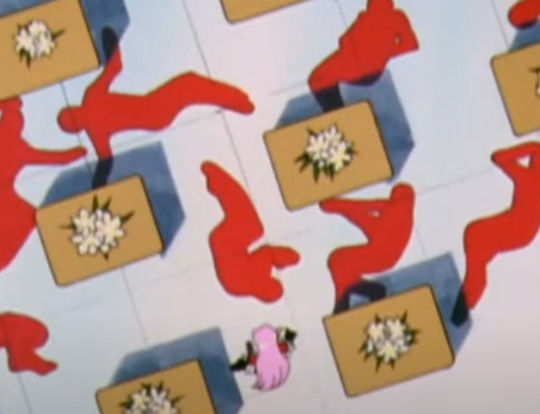
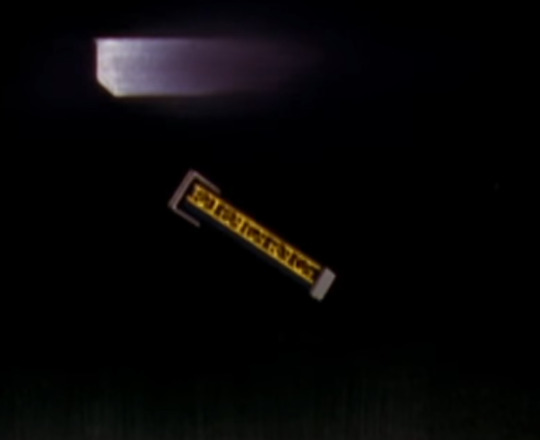
Mikage and the duelists are working on an entirely flawed premise - so each duel ends with another corpse in the crematorium and another chick that failed to break their shell and a return to status quo. Each person dueling is attempting to seek a revolution entirely defined by the perceptions or actions of others - Kaene wants Anthy’s judgement of her (perceived or not) gone. Wakaba wants others to look at her as special (especially Saionji). Kozue wants to protect Miki's innocence, but she also keeps wanting to taint it - her sweet love towards her sibling has turned curdled and she also wants to return to the 'Sunlit Garden'- so everyone who can taint it needs to go. Shiori wants to 'Win' over Juri because she can't believe in Juri's feelings in their clash with her abysmal self-worth and she can't accept her own feelings towards Juri. Tsuwabuki wants to be perceived as an adult and grow up already - though he isn't sure what it entails. Keiko wants to know Touga, and perhaps it is a plain desire common to most of Ohtori, but it’s not one that can be fulfilled while she is the lowest girl on the totem pole and Nanomi is in the way. Mikage himself seeks connection but the person he wants to connect to is terminally ill - so in the ultimate conclusion of this theme of rejecting the world he is seeking Eternity in these memories and reliving the past literally - he is a trapped ghost in a burned down building. The one person rejected is the Onion Prince boy whose basal confession is that he believes the problem is in him - not others.
Saionji
Saionji wants his status symbol back and to have something special that his 'friend' Touga doesn't have and Utena confronts him in revenge for her friend Wakaba first and revenge for Anthy's treatment once she is already committed - later episodes make it clear Wakaba still loves Saionji so it is doubtful that she would have wanted the duel in her honor. As Saoinji scoffingly points out - Utena is the archetypical prince protecting the honor of princesses here. Saionji's 'revolution' is related primarily to his status in the system - without Anthy as his rose bride he is no longer special - just an average upperclassman. His second duel is much the same because despite his belief that he has changed - he utterly fails to articulate 'how' and no other character can even notice how or if he is different. He still seeks to possess the Rose Bride as a status symbol of being 'an Adult' and gaining something that designates him as special - most specifically in regard to Touga. He is the only 2nd time duelist that comes without their own Rose Bride. He's not fighting with his own power/strength of will at all. He's repeating lines said by Touga in the first set of duels, Saioinji is an imitation of an imitation, and it's not very surprising he missed the memo on the change in duel format.
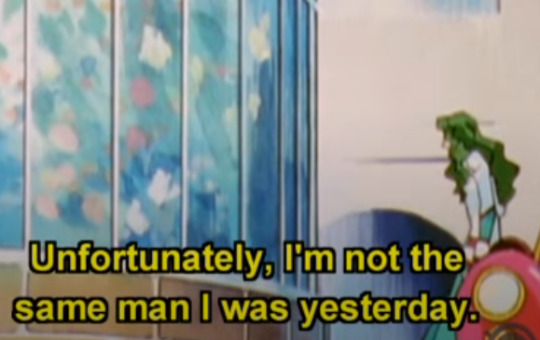

But he seems to have found the route start for the process of growing anyways after being beaten again. Refuting Touga in his desire to be like Akio and accurately pointing out the central premise of Ohtari. He repeats with Touga there is no such thing as True Friendship- but it is still evident that his relationship with Touga only improves again after they fail to complete their revolutions on Akio’s stage.

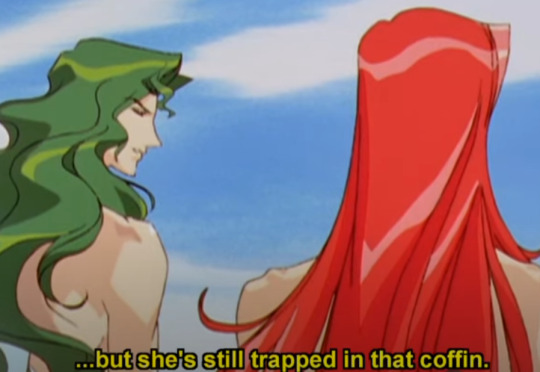
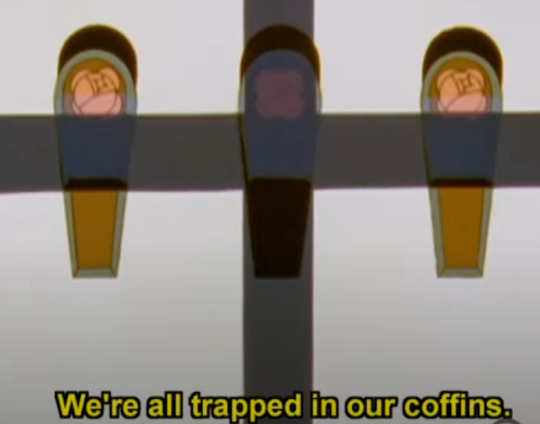
Miki
Miki wants to recapture his “sunlight garden” through Anthy. He is seeking a return to a state which was simple and joyful for him and believes if he can possess Anthy then he can return to that state. Of course, this simple state in his memory doesn't exist. He loses the duels both times because his illusion of how things were was shattered - first by realizing Anthy was cheering for Utena - she was not an empty vessel for his fantasy, second by realizing that both his sister and Anthy had elements of 'adulthood' - he thinks that he is ready to 'get dirty to get what he wants' in regards to maturing his relationship with Anthy and finally the stability and strength to make his place in the world secure. Both he and Kozue wants to have the strength to return to the Sunlight Garden, but only Kozue seems prepared to grab the power to hold the illusion together - in which case she chose an excellent model. Akio is a professional in the art of maintaining an illusion.

Miki ultimately seeks to return to simpler times because he feels estranged in the present - a chick without a home.
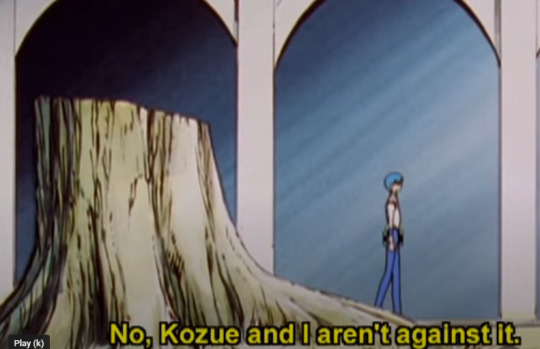
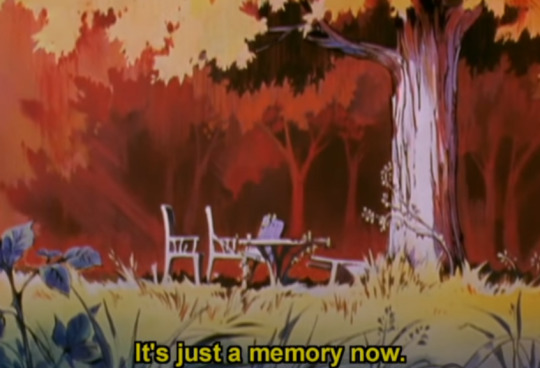
The problem is that his Sunlight Garden is a fragile thing since it is only a facade. Kozue seeks to grant her brother the power of 'Revolution' and take him to the 'world of adulthood' but his sword is still a 'child's sword'. Realizing that he can't return to the past he sought the ability to create a comfortable present - but he can't follow-through with the 'adulthood' embodied by Akio and complete his revolution on the carousel. Perhaps his Revolution requires him to stop trying to fit himself to the dichotomy of either a powerful prince ‘who takes what he want’ or an innocent and pure child ‘who has what’s his taken’ since no such thing as a 'pure prince' who exists without subjecting others or getting subjugated. Perhaps hope exists, he does know a friend or two who also don't fit comfortably into the defined archetypes of princess or prince.
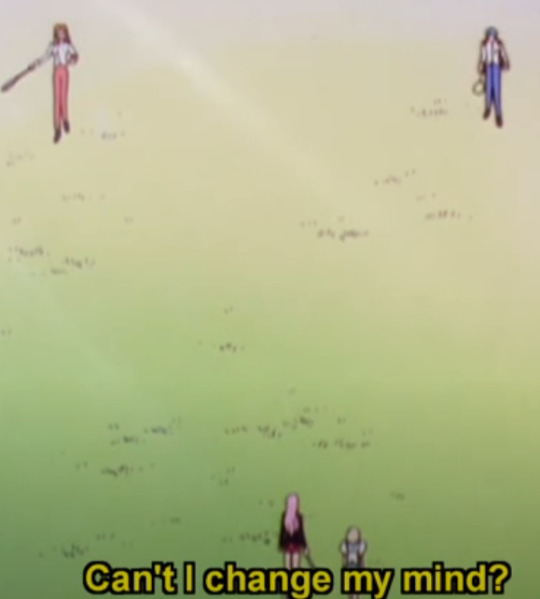
Juri
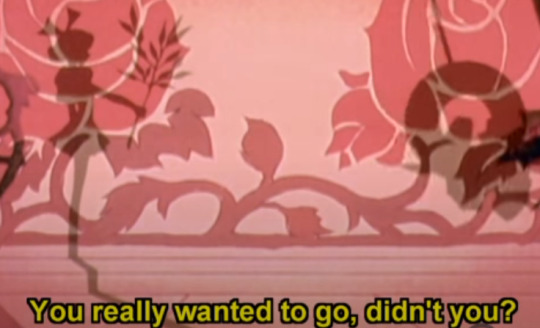
I understand Juri's issue in regard to her personal coffin - but I'm not actually sure the motivations behind her duels with Utena or what she is hoping to achieve. Juri's issue is that she doesn't believe in miracles (Shiori returning her feelings) but she really wants to believe in miracles (She can't give up her feelings for Shiori anyways). Her issue with miracles is "Believe in miracles and they will know your feelings" In this context, her duel with Utena is triggered by Utena telling how her Rose Crest links her to her 'Prince'. The parallel between miracles is the power to bring about connections - Juri challenges Utena to show her proof that her miracle - she will be led to her prince through her ring - is real while the camera focuses straight on Juri's locket - linking the two symbols. Juri believes there is no hope of her feelings or her being accepted if she communicates them to Shiori.
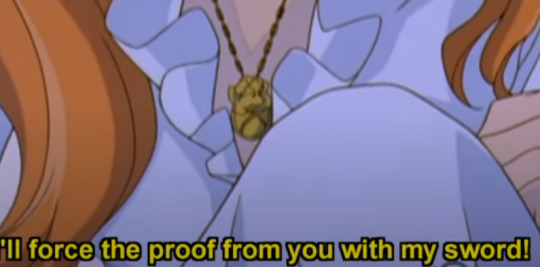
If she wins, she can continue to deny miracles exist while secretly hoping they exist - being engaged to the Rose Bride who is said to grant miracles - quietly locked into believing her feelings can’t be expressed. Losing - she still refuses to say out loud she believes in miracles - but it is still clear she is less hostile to the idea they can happen.
Juri's second duel starts with coercion - her anguish on seeing Shiori's humiliation and obsession with Ruka/Juri is outweighing her anguish on the uncrossable distance between Juri's feelings and Shiori despite their reciprocity. Ruka seems to love Juri and knows Juri loves Shiori and that Shiori can't and won't reciprocate with her issues, Juri loves Shiori but will neither reach out nor give up, Shiori loves Juri but refuses to believe that she is worthy so she must make Juri hate her. Juri and Ruka seem to share the idea - it's fine if they hate me as long as they are free from this toxic debasement that they are trapped in. Juri's growth hinges on accepting she shouldn't sacrifice herself for the sake of Shiori's miracle - love doesn't justify abuse. It is only by losing Shiori’s locket and letting her feelings (and fears) lay bare that Juri can break away in a new direction from the interruption into her cycle instead of a repeat of her past misfortune with Shiori.
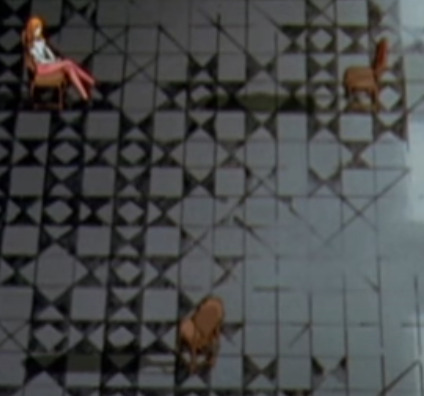

It seems that Ruka succeeds in his goal of letting Juri move on from her obsession with Shiori - though to what degree he intended anything is ambiguous since he goes and dies afterwards. Juri can accept letting Shiori leave her locket and accept it doesn’t need to require her suffering to love Shiori. Unrequited (or believed to be) love can be left to grow wistful - instead of a constant thorn in the heart. Juri has been given a direction to go for when she is ready to Revolutionize her world. She can still love Shiori, but she can't keep letting the rose parasite use its venom.
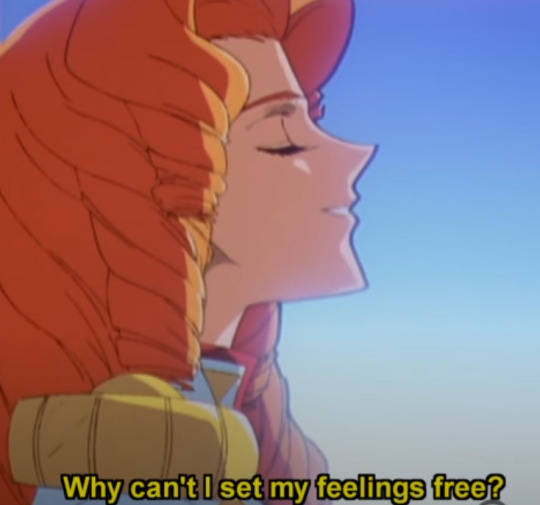
#revolutionary girl utena#proofread later#feel free to add commentary or evidence#feeling very literary analysis today#rgu#RGU meta#Mikage Souji#utena tenjou#juri arisugawa#saionji kyouichi
171 notes
·
View notes
Text
Elvis: chokers and suits, 1975
It's odd to me that not many people seem interested specifically on Elvis' choker pieces. I didn't find a website or any article (until now) on his 1975 chokers, naming them or something... just the jumpsuits and his jewelry pieces (rings and crosses and so on). Anyway, they are so essencial parts to his 1975 look!
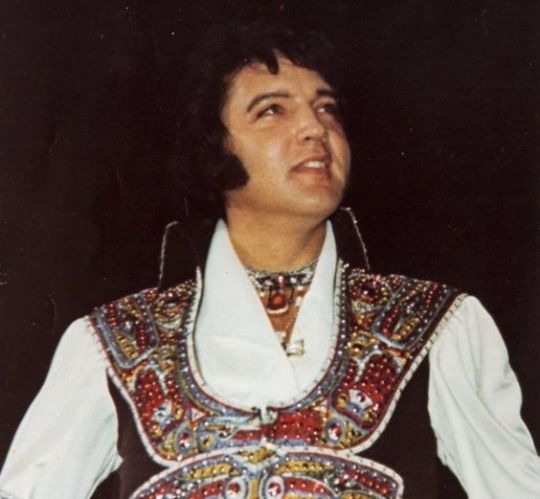
I'll never get tired of those 1975 pictures. Elvis looked like a baby, a teddy bear, a little boy in 1975, specially wearing chokers. He's just SO cute I wanna cry! ♥ 🥹 ♥
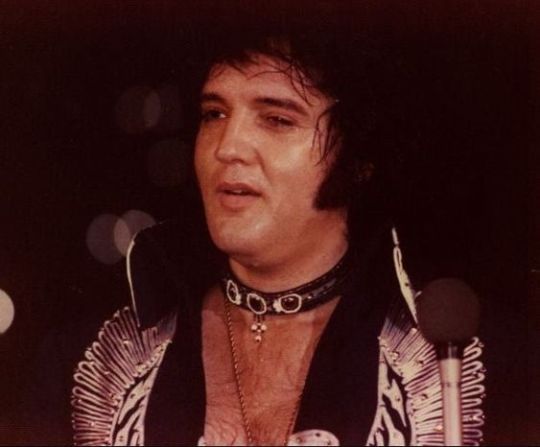
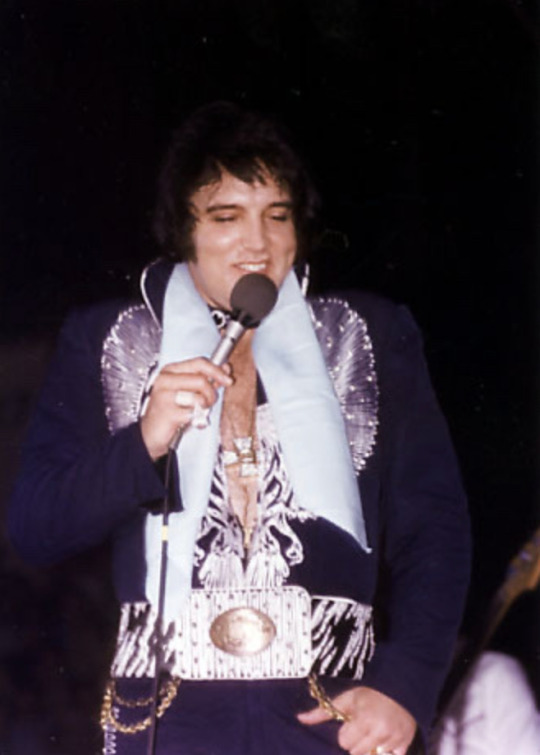
On the two pictures above, EP's wearing chokers with the ✨ Silver Phoenix (White/Silver Eagle) jumpsuit ✨ with the Black Phoenix belt. There were at least two different "Zebra Belts"; both designed for this suit.
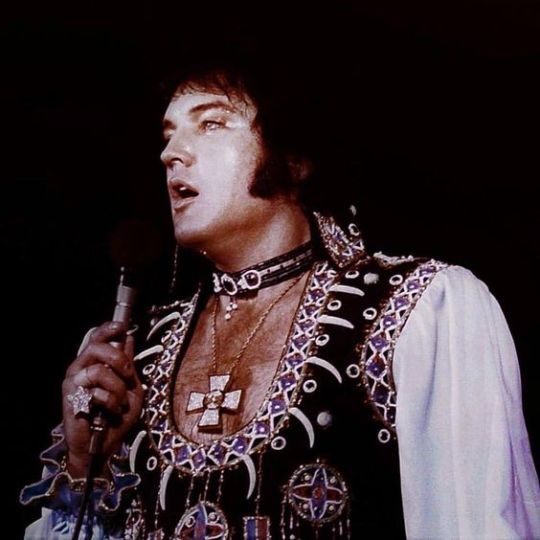
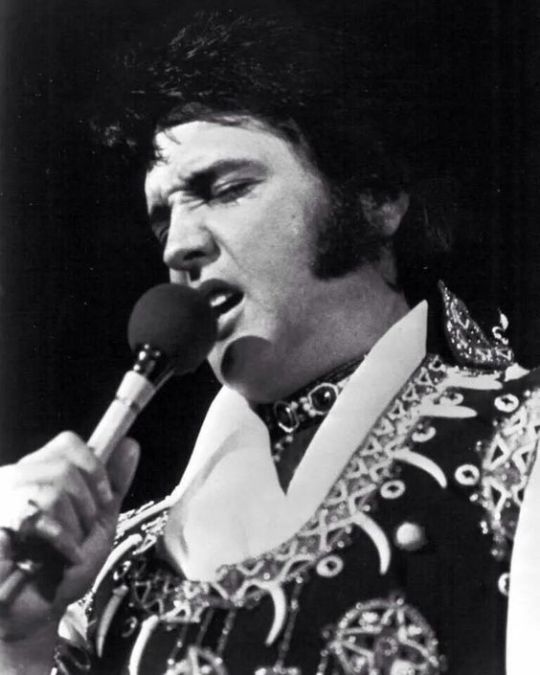
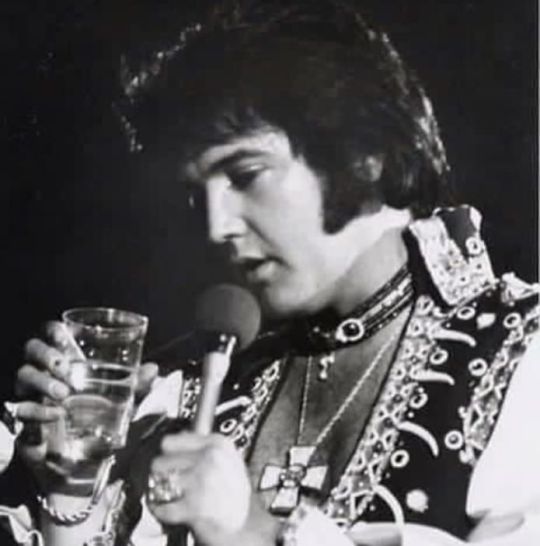
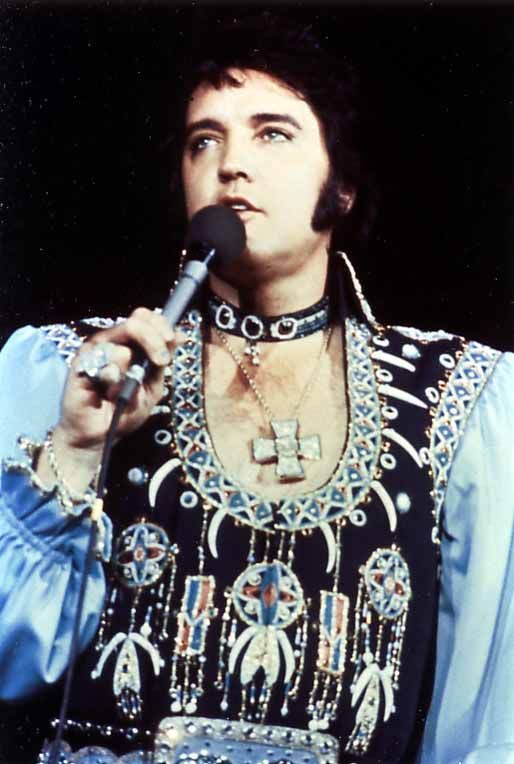
Above, from Summer tour from July 8 to July 24, 1975: Elvis Presley is pictured performing in the ✨ Chicken Bone suit ✨ (other names: Chicken Rib, Bear Claw, Black/Dark Blue Aztec). Black jumpsuit with light blue puffy sleeves (no, even tho some picture make the shirt look white, it was light blue). Elvis also used this suit a few times in 1976 with an alternative belt.
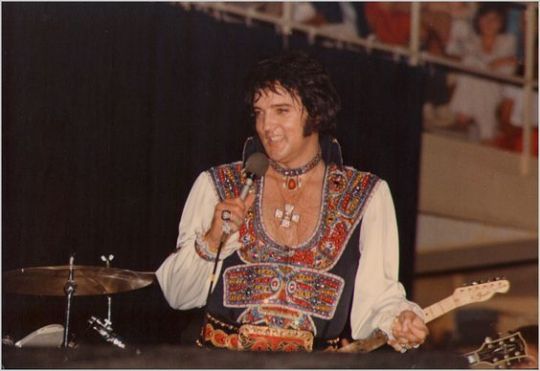
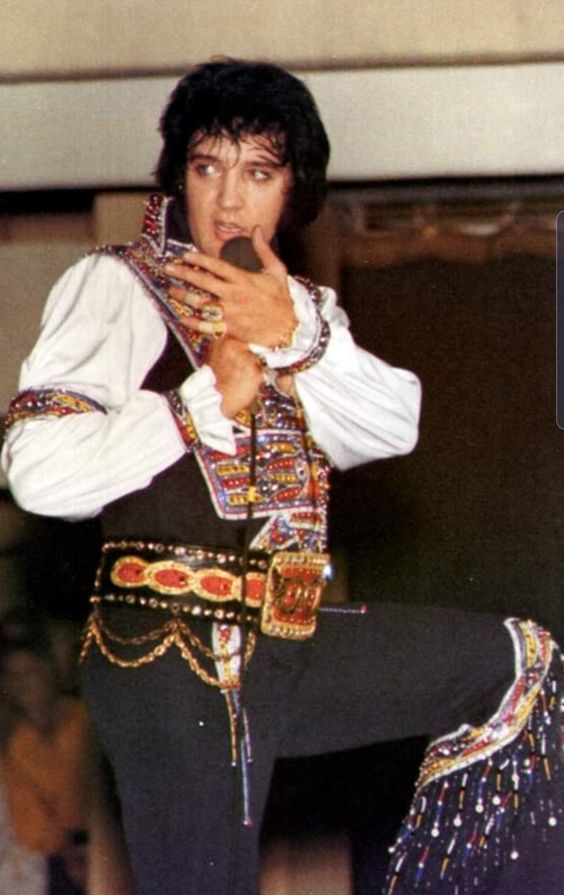
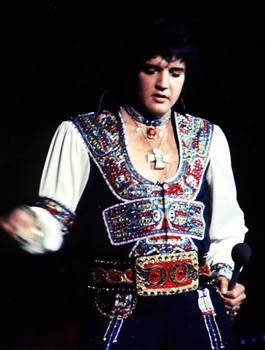
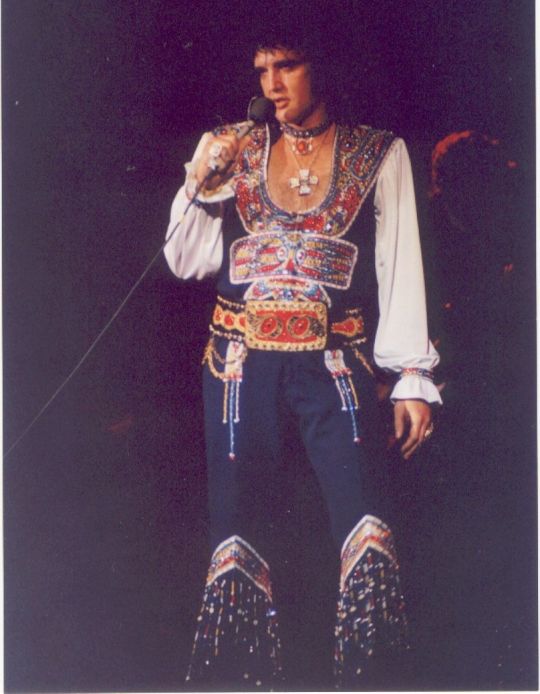
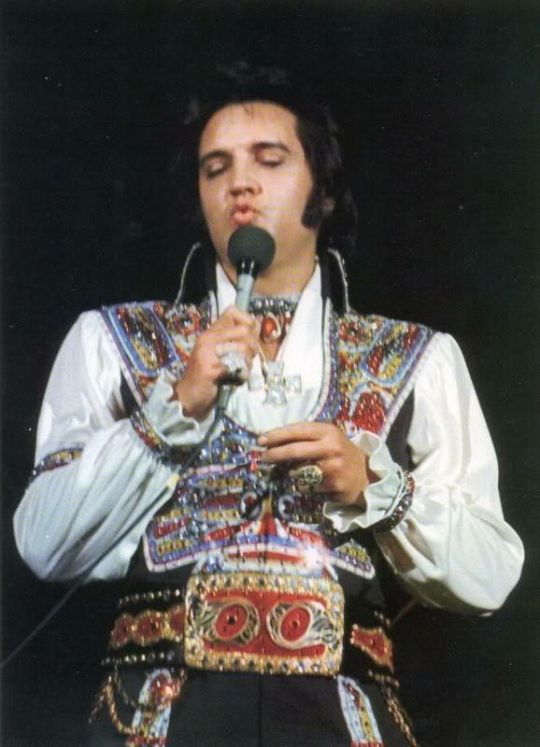
And my favorite one, the ✨Totem Pole (Gypsy) jumpsuit ✨ with the Red Armadillo Belt. This suit made its debut during the 1975 July tour, but when Elvis first wore it, he didn't wear it with the original belt. He wore it with a belt that was originally designed for the "Navy Blue Two-piece with Red armadillo", also a 1975 jumpsuit. The original belt was worn with this suit during his 1975 December Las Vegas engagement.

This very same choker Elvis used with the Gypsy suit he also wore the day those pictures below were taken:
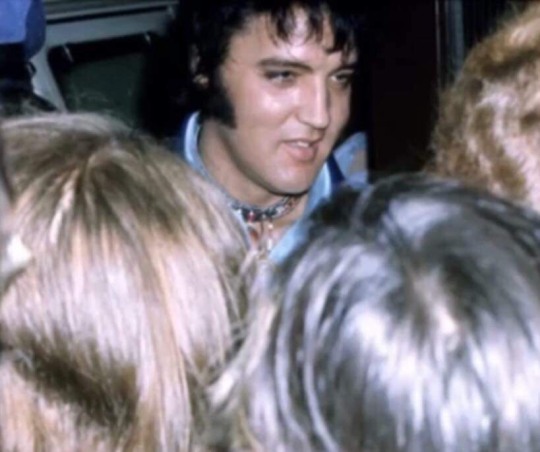
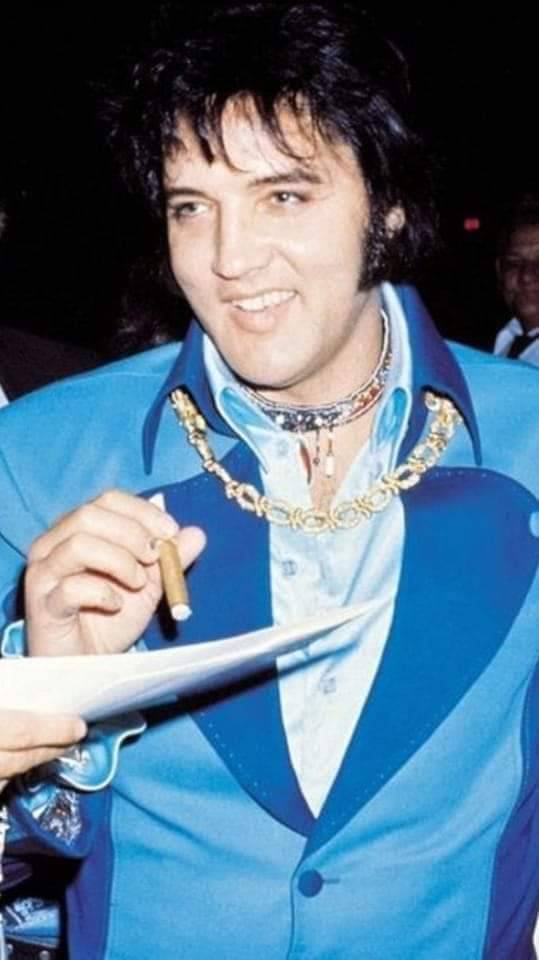
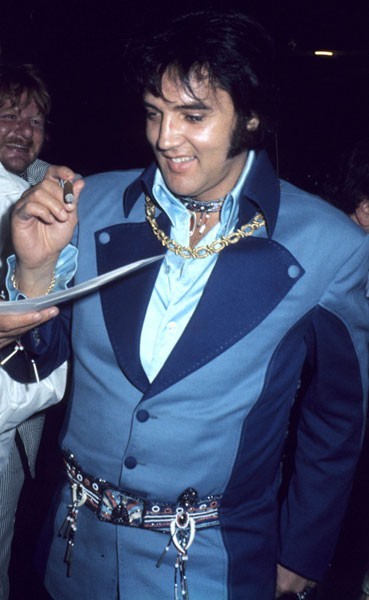
Smoking a cigar at JFK airport on July 19, 1975.
Anyway, Elvis wearing chokers is one of his best looks. ⚡
FOR MORE ACCURATE INFO ON ELVIS' JUMPSUITS: https://www.elvisconcerts.com/jumpsuits/index.htm
65 notes
·
View notes
Note
Gotta ask since we heard your guy's favorites, who's your least favorite out of your siblings/ other proxies?

Byte: Violent Violet is kind of amazing in how much she sucks??? At first, you think she's just awkward and kinda cowardly, but all her self-loathing disguises a lot of Mean Girl behavior. She's got this "I'm going to do it to you before you do it to me" mentality that is SOOOOOOOOO lame. She bullies anyone that's below her on the totem pole that exists in her head. Her only friends are her Collective, because at least they can ramble about Masky whenever she says something harsh.
Suzie: Don't forget the part where she almost got us all killed because she stole Sally's bear
Byte: OH RIGHT YEAH. THAT WAS HER FAULT, WASN'T IT. Btw, have you seen her recently? She hasn't texted in the group chat since Christmas...
15 notes
·
View notes
Text
reading more about atomic gardening and this is so much fun. to read about that is. it also seems fun to do, but. you know. anyway:
"The story of these citizen-pioneers of mutagenesis (the technical term for creating genetic change through the application of chemical, physical, and biological agents) is full of fantastic details, from Muriel Howorth’s propagandising ballet-mime, Isotopia, which involved a cast of Knowledge, Electron, Proton, Neutron, Rat, and Cow, as well as a working geiger counter, to Tennessee-based atomic entrepreneur C.J. Speas irradiating trays of seedlings into his backyard bunker.
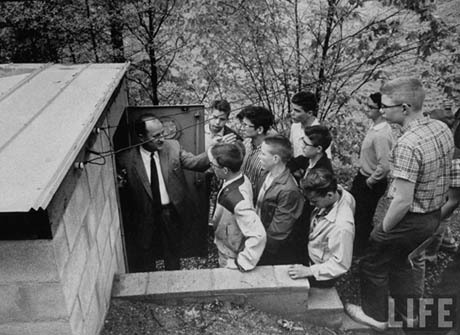
IMAGE: C.J. Speas giving a tour of his radioactive bunker to high school students, photo by Grey Villet for Life, via Pruned.
Perhaps the most bizarre detail in the interview, however, is the news that these gamma gardens are still in operation, relatively unchanged in design since the 50s, in the grounds of national laboratories today. Their circular form, which, as Johnson notes, bears more than a passing resemblance to the atomic danger symbol, “was simply based upon the need to arrange the plants in concentric circles around the radiation source which stood like a totem in the center of the field.”
It was basically a slug of radioactive material within a pole; when workers needed to enter the field it was lowered below ground into a lead lined chamber. There were a series of fences and alarms to keep people from entering the field when the source was above ground. The amount of radiation received by the plants naturally varied according to how close they were to the pole. So usually a single variety would be arranged as a ‘wedge’ leading away from the pole, so that the effects of a range of radiation levels could be evaluated. Most of the plants close to the pole simply died. A little further away, they would be so genetically altered that they were riddled with tumors and other growth abnormalities. It was generally the rows where the plants ‘looked’ normal, but still had genetic alterations, that were of the most interest, that were ‘just right’ as far as mutation breeding was concerned!
Over at GOOD, Peter Smith recently described a similar layout at the still-active Institute of Radiation Breeding, in Hitachiohmiya, Japan, which has “has a 88.8 Terabecquerel Cobalt-60 source, ringed by a 3,608-foot radius Gamma field (the world’s largest), and a 28-foot high shield dike around the perimeter.”
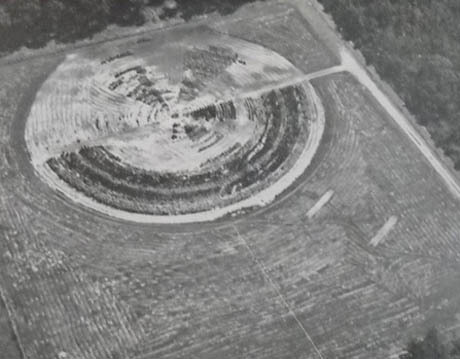
IMAGE: A gamma garden at Brookhaven National Labs, New York, c. 1958; image provided by Paige Johnson, via Pruned.

IMAGE: Aerial view of the Institute of Radiation Breeding, Hitachiohmiya, Japan.
As it turns out, far from being a fantastic fossil from the future that never was, along with jetpacks and flying cars, atomic gardening is alive and well today. According to a 2007 New York Times story, which quotes Dr. Pierre Lagoda, head of plant breeding and genetics at the International Atomic Energy Agency, radiation breeding is actually experiencing a renaissance, due to the introduction of “new methods that speed up the identification of mutants.”

IMAGE: Mutant crop varieties mapped by The New York Times.
What’s more, the Times adds, nearly 2,000 gamma radiation-induced mutant crop varieties have been registered around the world, including Calrose 76, a dwarf varietal that accounts for about half the rice grown in California, and the popular Star Ruby and Rio Red grapefruits, whose deep colour is a mutation produced through radiation breeding in the 1970s. Similarly, Johnson tells Pruned that “most of the global production of mint oil,” with an annual market value estimated at $930 million, is extracted from the “wilt-resistant ‘Todd’s Mitcham’ cultivar, a product of thermal neutron irradiation.” She adds that “the exact nature of the genetic changes that cause it to be wilt-resistant remain unknown.”
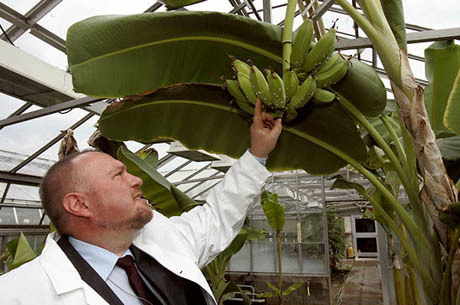
IMAGE: “Pierre Lagoda, the head of plant breeding and genetics at the International Atomic Energy Agency, showing mutated plants at a greenhouse in Austria,” photo by Herwig Prammer for The New York Times."
35 notes
·
View notes
Text

With Lalaloopsy being originally made in the 2010s, it makes sense that some of the dolls would end up becoming problematic. One of those dolls is Feather Tell-A-Tale. Her design is a walking stereotype of an indigenous girl and her name isn’t helping either. So I took a swing I redesigning her.
For starters, Feather isn’t clearly a part of a specific indigenous tribe. I specifically went the North American Cheyenne tribe. In fact, I color picked her skin tone from a photo of an actual Cheyenne woman. Another thing I did was darken and lengthen her hair. Most native Americans have dark brown/black hair, so I just made her hair a darker blue. Native Americans also have high spiritual value of their hair; it connects them to their identities, family, and community. Because of this, they grow it out. So, I lengthened her hair.
The shirt is actually a poncho from an actual traditional Cheyenne outfit and her earrings are actually real, being made by an actual Cheyenne person. I also made her totem pole bears into two cuddly bear cubs. Finally, I changed her name. I searched for quite a while before settling on Pahoevotna’e, which means “attached feathers woman” in Cheyenne.
If any indigenous people (and especially Cheyenne/Native American people) stumble across this, PLEASE give me some critiques. I want to make sure I’ve made Feather’s new design accurate to your culture.
7 notes
·
View notes
Text

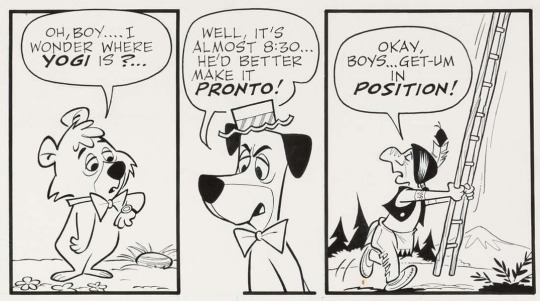



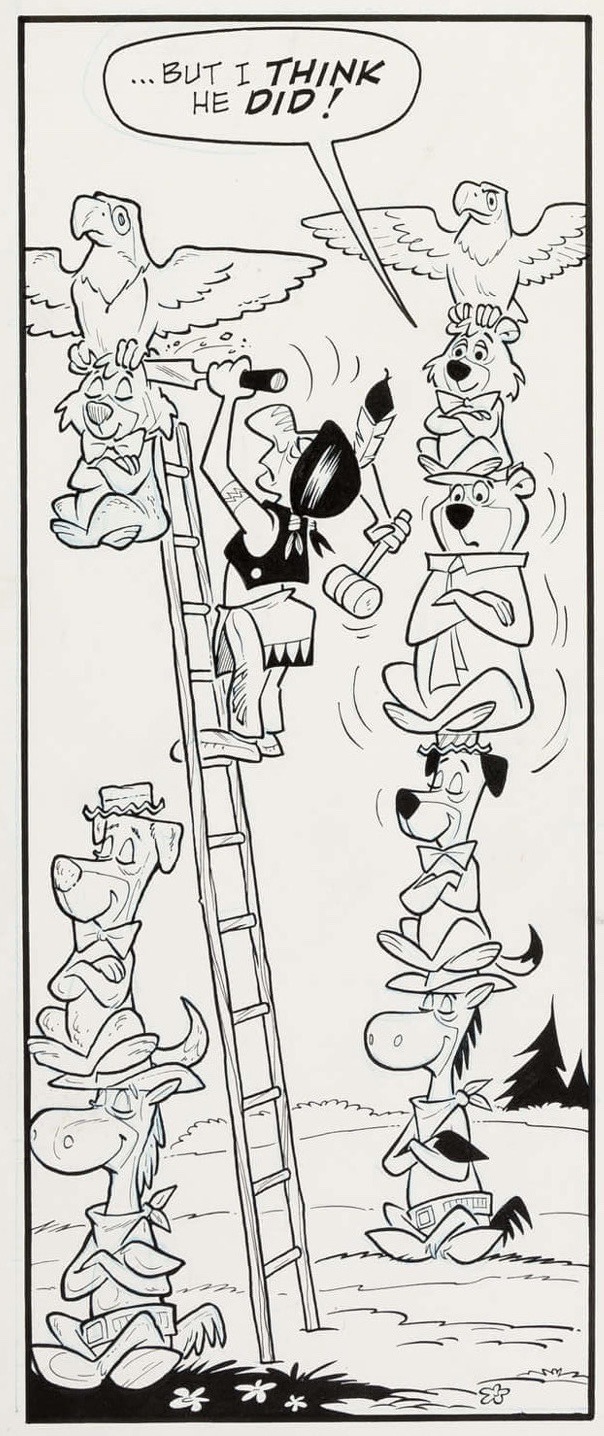
Totem Pole Models “Yogi Bear Sunday Strip” (1968)
#60s#hanna barbera#mcnaught syndicate#yogi bear#comic strip#sunday comics#character designs#boo boo bear#huckleberry hound#quick draw mcgraw#Gene Hazelton
28 notes
·
View notes
Text
Does anyone remember these games I played as a kid?
I feel like they were made by Nick Jr but I haven’t found anything about either so I’m not sure
The first game was set on a train. You could go onto different carts and do different educational games. I remember some carts would have a video where you could just watch an episode of any cartoon from whatever company that made this. I also remember it going from daytime to nighttime, no clue if it depended on the actual time of day
The second one was either a game by itself or a game based off a cartoon (If it was a cartoon then I wanna say 2010s) It was a school full of different animals who all looked very shapey. I don’t remember all of them but I remember one student was a rino and the teacher was a bear. (He’s not. Oopsies) There was a bunch of different games you could do but I only remember two. One was just coloring and the other you could make a totem pole. And there was a little animation of the kids going home at the end of the day
If anyone remembers these, let me know 😭
Edit: the second one has been found. It’s Hey Duggee! :3
9 notes
·
View notes
Text
mm ok I have something to talk about finally ! so something I’ve noticed in a lot of discussions/meta around the TFW2.0 family dynamic + cycles of abuse is that it almost always opts to frame jack as a perpetual victim of [sam and] dean’s mistreatment who can’t fight back, and while I don’t mean to say it’s completely without merit, I feel that it does a slight disservice to Jack’s character by always reducing him into a helpless child (even if he is seen as older by the poster) who cannot/should not bear any responsibility in any of his relationships with his fathers.
to start, the cycle of abuse coincides with an imbalanced power dynamic; someone with more or higher power and authority over you (ie parent, boss or teacher) uses that authority to exploit, control, and/or freely mistreat you. i will note that it doesn’t necessarily have to be framed this way to be abuse, like a situation where blackmail grants someone authority over their target; there are also some dynamics that are inherently imbalanced without being inherently abusive (see above examples). the abuse relies on that dynamic being manipulated, not the dynamic itself.
in the majority of posts I’ve seen, the power imbalance between TFW2.0 almost always puts jack at the bottom of the totem pole, in a constant state of victimhood because he’s constantly at the mercy of [sam and] dean [and cas].*boxed these in bc people rarely pick on sam or cas for their transgressions and whether or not they’ll kill him. clarifying again that i understand where this comes from, but I also think it’s a fairly dated perspective on their dynamic that should really be re-examined—especially with Jack’s autonomy more in mind—and i believe @shallowseeker has a post about the exact timeframe of Cas’ death and Dean’s widower arc/mistreatment of Jack that i recommend for it.
but onto my main point, I feel that this representation of their dynamic is inaccurate, and doesn’t really take jack into account beyond the Helpless Child Victim narrative. for the sake of staying on topic let me just summarize a few things:
A) Jack is the most powerful being in the universe and is functionally immortal/unkillable. He is a greater threat to TFW than they are to him, and so he is the one with power in the dynamic, not the other way around. It all hinges on his personal choice to not harm them (because he loves them of course).
B) Jack is and always has been painfully aware of his power, the threat he poses, the dynamic it creates and the underlying tension it constantly causes with his relationships. The majority of his actions and motivations are rooted in his own self-fear, and the determination to prove he’s good/safe.
Another small point I’ll shove in is that Dean canonically never forgave himself for his mistreatment of Jack, and spent almost the entirety of their relationship trying to make up for it (especially in 14x06, 07 & 08). Likewise, Dean’s promise to kill Jack in 13x02 and that scene from Moriah are both often misunderstood as more Textbook Dean Abuse with **Jack’s perspectives (ie: “dean said he’d kill me, and maybe he should,” his admission of guilt and willingness to let Dean shoot him) (also, his choice to forgive dean at some point offscreen) being largely overlooked.
**obviously it’s not healthy or good for Jack to basically consent to being mistreated or killed because he thinks he somehow deserves it, nor does it make Dean’s actions excusable or justified in any way, but i still feel that it’s worth pointing out as examples of Jack’s autonomy and awareness in the aforementioned power dynamic.
Jack’s responsibility is also pretty unaccounted for in these dynamics (especially when it comes to Mary’s death) which I think stems equally from the fact that his soullessness—and by extension, his soulless actions—were caused by Sam and Dean’s actions and the general perspective of him as a child [who doesn’t deserve the burden he carries, and should be carefree], so nothing is directly his fault and nobody can get mad at him either or that’s also seen as unfair mistreatment). I also personally just think it’s odd because Jack in canon is very adamant about being able to take and hold responsibility (as it relates to his autonomy and wanting to be seen as a separate person from his parents). and, going back to Mary, Jack not only becomes psychotic with guilt over killing her, but after his soul is restored in S15, he has a complete breakdown from the sheer horror of what he’s done, and because, in his own words, it’s all his fault.
I won’t go into the worm can of people blaming Dean for how he handled reliving to his root trauma, but suffice it to say: he had every right to be angry, he was well within reason to act unreasonably, and stop trying to fix his conflict with jack by parentifying him with an innocent baby when he already has parentification trauma and that baby is merely an excuse to absolve Jack of any responsibility he had in the conflict.
I will always and forever love the meta side of the fandom, and I honestly owe my blog’s existence to it, but I still think we have a long way to go in terms of how jack is represented/portrayed in these discussions, and likewise, how that portrayal frames/reflects on sam, dean and cas ^_^
#cal.txt#spn#supernatural#spn meta#spn fandom#fandom discussion#tfw 2.0#team free will 2.0#jack kline#sam winchester#castiel#dean winchester#sam and jack#dean and jack#cas and jack#dadstiel#also we absolutely do not put cas through the wringer as much as we should#but that’s for another post I think#spn analysis#dad!dean#dad!sam#jack meta
28 notes
·
View notes
Text
Cultural Architecture: NWT Totem Poles - The Specifics Pt. 1
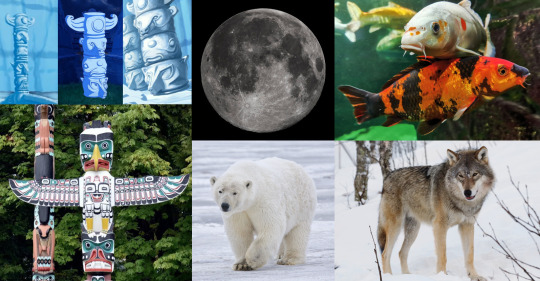
Among most of the totem poles we see throughout the Northern Water Tribe (NWT), four representations appear consistently throughout.
Ocean & Moon
The top section of the pole has wing-like extensions jutting out, with a circle design on the actual totem. I believe that the extensions are actually stylized ocean waves and the circle represents the moon. In short, I believe the top totem represents the moon spirit and ocean spirit; by extension, the top totem also represents waterbending. Given that the NWT's society is especially dependent on bending, it makes sense that this symbolism would be represented at the very top of their totem poles.
Polar Bear
The second totem, with its wide-set face and round ears, is clearly meant to represent a polar bear. As I mentioned in a previous post: In Inuit religion, Nanook (Polar Bears) are considered to be the masters of all bears. Inuit hunters worshiped the Nanook as they believed it was the bear who determined if the hunt would be successful or not. Respect was given to Nanook by the hunter hanging the bear’s hide in a special section of his igloo, where it would stay for several days. Legend says that if a dead polar bear was treated properly by the hunter, its spirit would share the good news with other bears who would allow themselves to be hunted. Bears would stay away from hunters who failed to pay respect.
Through the second totem, we see more of the Water Tribe's Inuit influence. We also get more hints of how important hunting and respect for nature is to the culture of the NWT.
In the next post, I'll cover the significance of the koi and wolf heads.
Like what I’m doing? Tips always appreciated, never expected. ^_^
https://ko-fi.com/atlaculture
172 notes
·
View notes